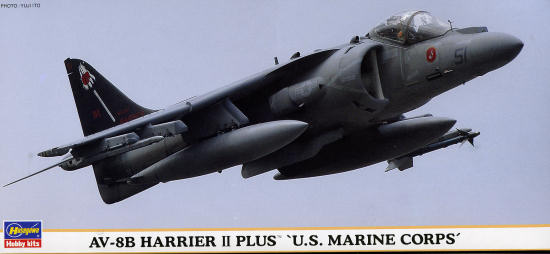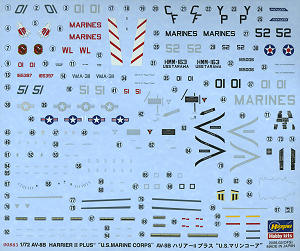
Hasegawa 1/72 AV-8B Harrier II Plus 'US Marine Corps'
| KIT: | Hasegawa 1/72 AV-8B Harrier II Plus 'US Marine Corps' |
| KIT #: | 0883 |
| PRICE: | $26.95 SRP |
| DECALS: | Three Options |
| REVIEWER: | Scott Van Aken |
| NOTES: | Reissue with new decals. |

| HISTORY |
Still the world's only large scale production VTOL aircraft, theAV-8B Harrier is a major rework of the earlier AV-8A variant. Spurred by a USMCrequirement for larger payload capabilities, the AV-8B was developed byMcDonnell Douglas and after a rather protracted gestation period entered Marineservice in the mid 1980s. The major differences between it and the earlier AV-8Aare a larger wing of supercritical design and a different nose section, allowingthe pilot a greater field of vision.
The increases wing size provides for more hardpoints, allowingthe AV-8B to carry a greater array of ordnance than the earlier Harrier. Theaircraft also has a more powerful engine and is a bit longer as well, enablingthe plane to carry more fuel for greater range. Getting all of this together andstaying within the required weight limitations was no mean feat. Development ofthe aircraft took a bit longer than one would have expected in order to makesure that all requirements were met. The RAF Harrier GR.5 is a very similaraircraft. The AV-8B has been developed into even more improved versions, most ofwhich can be spotted by the different noses on the aircraft. The same can besaid of the RAF Harrier GR.7 and GR.9.
| THE KIT |
 I'm not sure just how many times this kit has been reissued, but each one has come with recent markings from the various units flying the type. Today, this is good as Hasegawa's 'new' decals are as good as anything you can get from aftermarket. Please note that I took the lazy way out and used the standard AV-8B sprue image. Only difference is the inclusion of the plus nose and the scabbed chaff/flare pods.
I'm not sure just how many times this kit has been reissued, but each one has come with recent markings from the various units flying the type. Today, this is good as Hasegawa's 'new' decals are as good as anything you can get from aftermarket. Please note that I took the lazy way out and used the standard AV-8B sprue image. Only difference is the inclusion of the plus nose and the scabbed chaff/flare pods.
The moldings are in excellent shape; still nice and crisp with no flash. Ejector pin marks are, as is often the case, on landing gear legs, one side of the pylons, on missile bodies and the inside of gear doors. Cockpit is nicely done for this scale, with decals for the side consoles and main instrument panel. A somewhat basic seat is provided. Intakes are molded with the upper bleed down doors in the open position, as is the norm when on the ground.
 Polycaps are used to allow the exhaust nozzles to be rotated. The main gear doors are properly shown in the closed position. One has a choice of lower fuselage guns or strakes. A pair of Sidewinders is provided for the outer missile pylons and fuel tanks for the inner wing pylons. Any other ordnance will have to come from the usual weapons sets. A two piece canopy/windscreen is provided so the cockpit can be more easily displayed.
Polycaps are used to allow the exhaust nozzles to be rotated. The main gear doors are properly shown in the closed position. One has a choice of lower fuselage guns or strakes. A pair of Sidewinders is provided for the outer missile pylons and fuel tanks for the inner wing pylons. Any other ordnance will have to come from the usual weapons sets. A two piece canopy/windscreen is provided so the cockpit can be more easily displayed.
Instructions are typical for Hasegawa and are well done with Gunze Paint references. I have my doubts about the colors for the camouflage as Hasegawa calls out 35237/36320/36375 for the three greys. I think the darker shade should be 36118. Decals are superbly printed and provide markings for four aircraft. Two are the box art unit, VMA-311 with one being just a nose number/pilot change. The black tails will have to be painted by the builder. The other two are from VMA-211. The difference in this case is that one has the codes and name of the deployed helo unit when these planes are on cruise. In this case, the markings are for HMM-163 aboard the USS Tarawa.
| CONCLUSIONS |
If you have never built one of these 1/72 Harrier II kits, you really ought to give one a go. They build into very nice models and are something you should have on your shelf.
April 2008
If you would like your product reviewed fairly and fairly quickly, please contact the editor or see other details in the